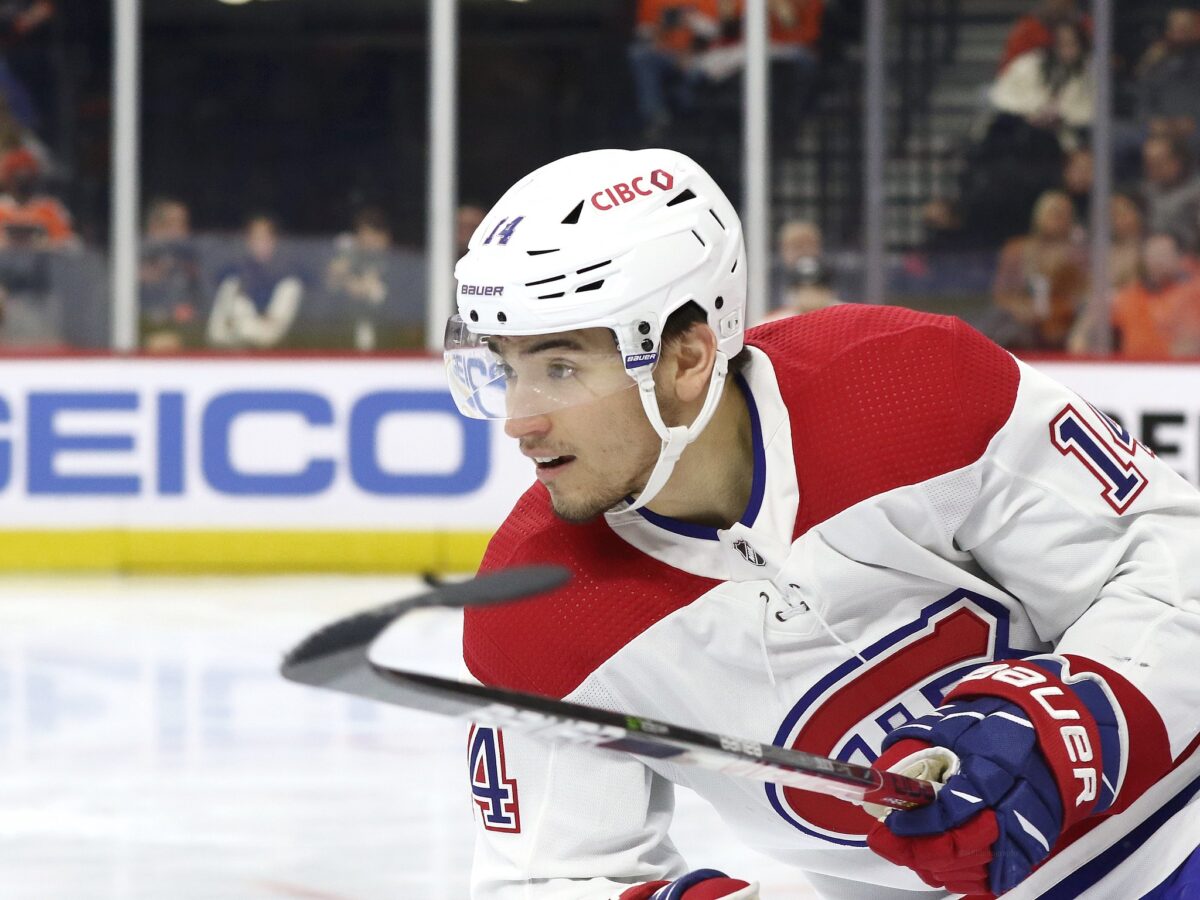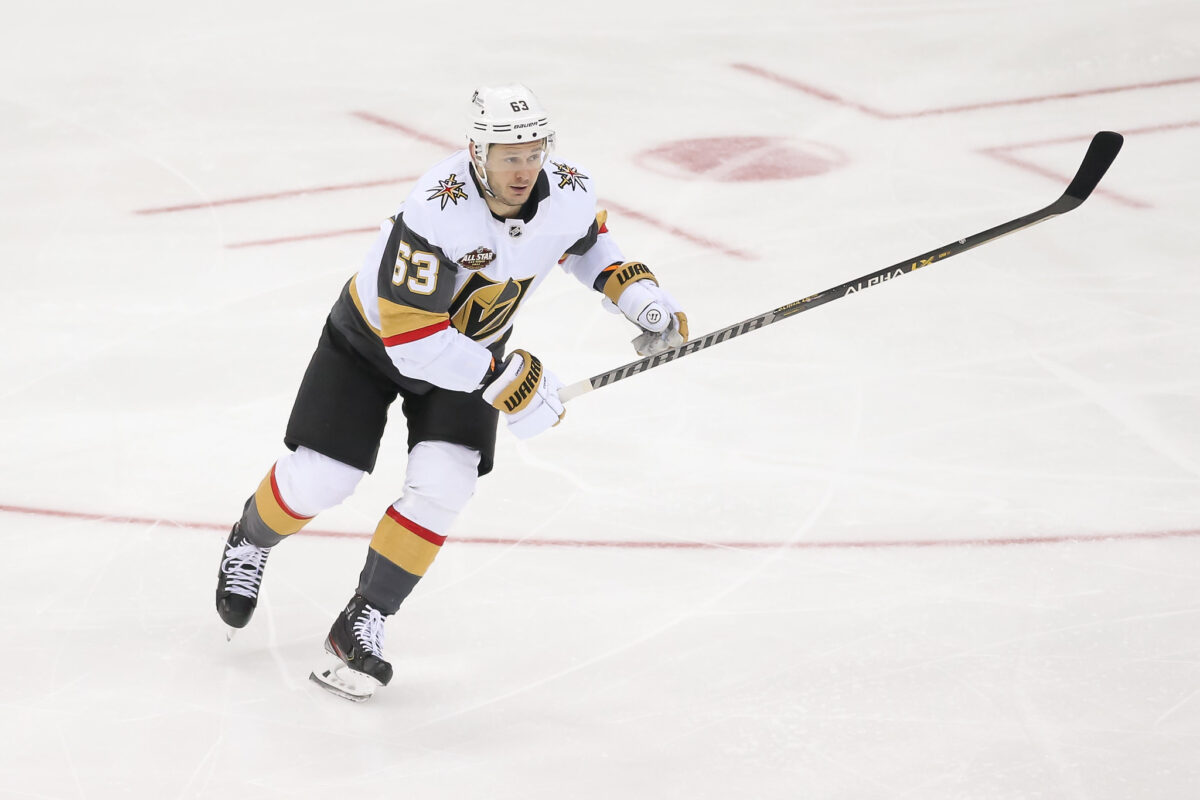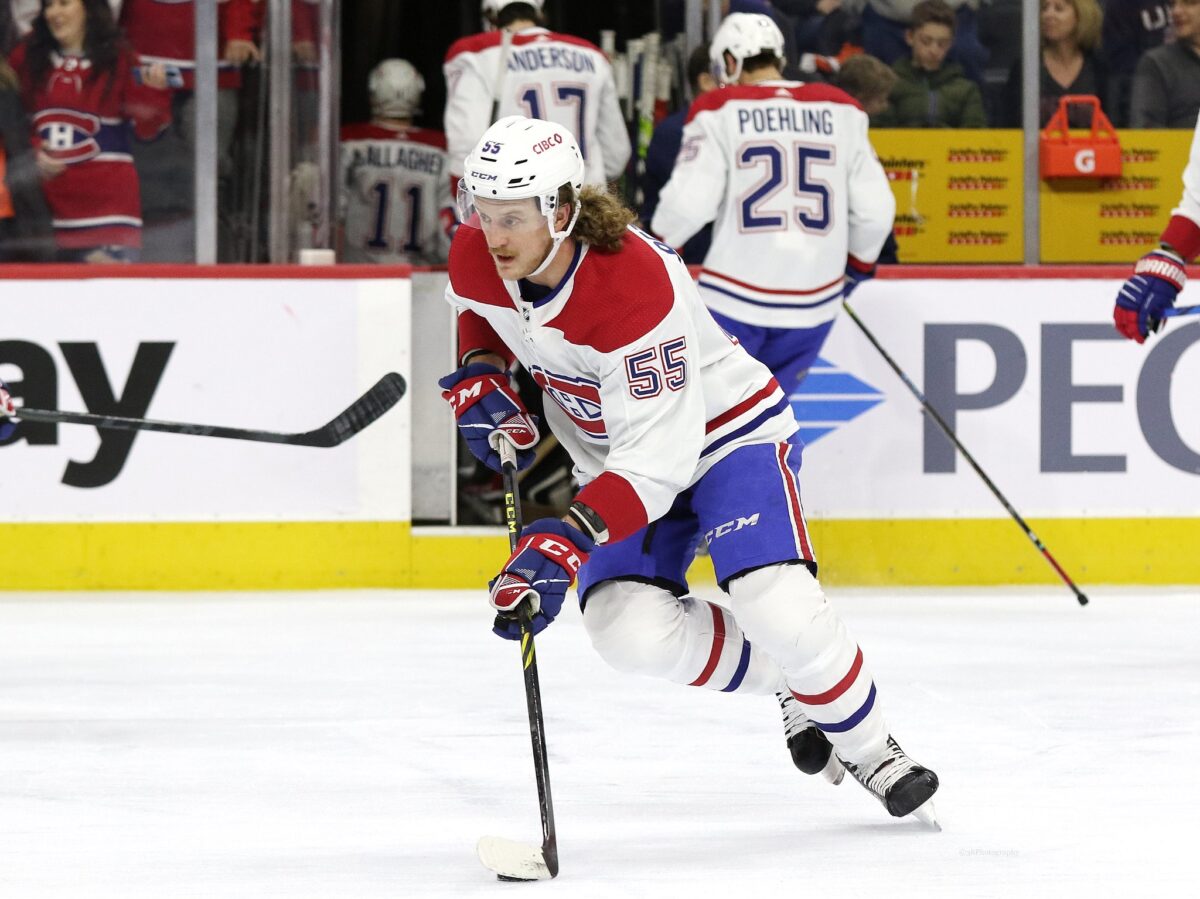As training camp approaches, there will be debates on what to expect from the Montreal Canadiens. Specifically, what further moves will general manager Kent Hughes make? What kind of production could be expected from each player?
Here, we will look at what we can reasonably expect from the Canadiens roster this season and by using Trege Wilson’s THW lineup projection. In this article, we’ll only cover the forwards. We will be using last season’s production as a starting point and adjusting for their expected role and responsibilities this season. Keep in mind that this will be a Habs lineup expected to finish near the bottom of the NHL standings. The defence and goaltending will get done in a separate article.
Forwards
The Canadiens are entering training camp with as many as 16 NHL forwards, many of whom are veterans with big enough contracts to make them difficult to trade. Basically, there is no shortage of forwards in the system. Thanks to there being as many as 16 forwards under contract that have NHL experience, coach Martin St. Louis has multiple options to build his lines.
Expected Lineup
- Juraj Slafkovsky – Nick Suzuki – Cole Caufield
- Jonathan Drouin – Christian Dvorak – Josh Anderson
- Sean Monahan – Kirby Dach – Brendan Gallagher
- Evgenii Dadonov – Jake Evans – Mike Hoffman
- Rem Pitlick
- Joel Armia
Top Line
The top line will have Nick Suzuki and Cole Caufield, as they have built tremendous chemistry over the last year. Expectations for these two will be elevated after Suzuki had a career season, scoring 61 points while averaging over 20 minutes per night against the top lines in the league. Caufield exploded for 22 goals and 35 points in 37 games under St. Louis, and that pace will need to continue to keep the games competitive this season.

The wild card is the addition of the 2022 first-overall pick, Juraj Slafkovsky. On paper, his 6-foot-4, 227-pound frame and physical style built on speed fit well with that pair, but it may be a stretch to expect him to stay on the top line all season. Despite playing professionally since he was 16 years old, he will need time to adjust to the NHL. If he can finish the season with close to 40 points, a role on the power play, and an average ice time of around 17 minutes per night, all while being highly competitive, that would be considered a successful rookie season.
If Slafkovsky does more than that, it would be even better. He will also need to be prepared to spend time with the Laval Rocket, the Canadiens’ American Hockey League (AHL) affiliate. Regardless of which league he ends up aging in, the main focus will be to provide him with opportunities for development.
Second Line
This line will need to help insulate the younger forwards by taking on some of the more difficult defensive assignments. Christian Dvorak will be looking to rebound from a disappointing and injury-filled 2021-22 season, as he will need to play a shutdown role while also adding to the team’s overall offensive production. If he can score 45 to 50 points, it would go a long way in helping the Canadiens and also raising his trade value.
On his right wing is Josh Anderson, who the Canadiens will look to play as a power forward more consistently. It will be important for his line’s success for him to consistently use his speed and physical play to intimidate opponents in chasing him around the zone, creating confusion in their zone coverage and giving his linemates more space as defences focus on him. The expectation is to see him score 25 goals and lead the team in hits.
Related: Montreal Canadiens 2022-23 Training Camp Predictions
On the left wing is oft-injured Jonathan Drouin. The 2013 third-overall pick has not yet met his potential in the NHL or the expectations heaped upon him when he arrived in Montreal. He is capable of adding 20 goals and 50 points, but that is only when he is healthy. This season, he enters the final year of his six-year contract worth $5.5 million, and he will be motivated to prove he deserves another deal. If healthy, he should be able to reach the 50-point plateau and raise his trade value to provide Hughes with an intriguing player to use to add assets for the rebuild.
Third Line
Kirby Dach’s arrival was a surprise. It’s rare for a rebuilding team like the Chicago Blackhawks to trade a 21-year-old center who was drafted third overall only three seasons before, even if he hasn’t reached his potential yet. Joining another rebuilding team with Suzuki, Monahan, and Dvorak all available to insulate and mentor him will make Montreal a good environment for him to further develop his game.
Also, he has the luxury of time to prove he has recovered from his wrist injury. Expectations for Dach should include him playing as a competent middle-six center who is capable of winning over 50 percent of his faceoffs. If he can do that, his production should naturally follow and improve from his 26 points last season.
Brendan Gallagher will be highly motivated to prove that his issues last season stemmed completely from a lack of recovery time in the offseason and injuries.
There’s not a single doubt [I’ll be able to get back to where I need to be]. I understand I didn’t meet [production] expectations, but there are just a lot of things that I know that the outside world doesn’t really know that’s going on
Brendan Gallagher
Gallagher should always be taken seriously. With his motivation to prove that last season was an anomaly and that he is still capable of leading the team while also producing offensively, the expectations for him this season should be high. Realistically, he will not reach the 30-goal plateau again, but playing in a top-nine role, a 20-goal, 50-point season is needed from him as much as his consistent 100 percent effort on every shift.

Another player looking to prove himself worthy of his contract is the newly acquired Sean Monahan. The difference between him and Gallagher is that Monahan has had two years of serious injuries and is entering a contract year when his six-year deal worth $6.375 million is set to expire. Expectations for Monahan are low; the Canadiens acquired him as a cap dump along with a first-round pick. If he can play more than 45 games and provide some defensive ability and mentorship for Dach, then it would be a home run — even without any production.
Fourth Line
The Canadiens will need a fourth line capable of more than just playing an occasional shift to provide rest to their special teams after a power play or killing a penalty. They will need one that can provide energy on a regular shift. The responsibility of centering this line will fall to Jake Evans, who is entering his third full NHL season and has shown himself capable of successfully filling that role. Expectations will be high, even as a fourth-line center, for him to repeat last season’s 29-point performance and to average at least 15 minutes per game. A successful season for Evans would also need a faceoff percentage above 50 and a regular shift on the penalty kill.
Evgenii Dadonov joins the Canadiens from the Vegas Golden Knights after they took on Shea Weber’s $7.85 million contract to create long-term injury reserve (LTIR) space so that they can spend above the cap, a move that also helps the Canadiens’ salary cap structure. That doesn’t mean he is without value, as he is coming off his fourth 20-goal season and is expected to reach that level again.
Another expectation is for him to help elevate a power play that finished 31st with a 13.2 percent success rate. He will be motivated to play at his best in a contract year, which would help make him attractive to a contending team at the trade deadline. This is what the Canadiens are hoping for so as to maximize his trade value, as Hughes will likely use the veteran in a trade to add assets to continue the rebuild.

Rounding out the line is Mike Hoffman. Signed to a three-year deal at a cap hit of $4.25 million last offseason by former GM Marc Bergevin, his 15-goal, 35-point season was a disappointment, especially since he was signed to help the power play and only added 13 points in that role. Expectations for him aren’t very high, especially defensively. He isn’t known for his ability to play passable defence, so unless he is producing 25 or more goals per season and scoring regularly on the power play, he is more of a hindrance than a help.
If he can meet that threshold in 2022-23, Hughes may be able to find a rival GM willing to take on his contract, allowing for the Canadiens to open up a roster position for a prospect. But no one is holding their breath on him meeting that level of expectation.
Wild Cards
There are three more players under contract that the Canadiens will use as more than just spare forwards. The first one is Rem Pitlick. After being acquired as a waiver pickup last season, he was able to play in any forward role while also providing speed and ended up producing 26 points in 46 games. This versatility and ability to play with pace, which fits well with St. Louis’ system, should have him in the lineup sooner rather than later and playing most of the season. Expectations may be too high, especially if they expect him to continue at the same pace as last season. But if he can get into 50 games and provide 25 points, that would be a highly successful campaign for him. However, that means someone above had a terrible season, or hopefully, that they were traded out to help with the rebuild.
Joel Armia is another spare from this lineup. After his impressive play during the team’s 2021 Stanley Cup Final run, he signed a four-year deal worth $3.4 million annually. But in the first season of that deal, his play left much to be desired. His 14 points in 2021-22 was a far cry from his career high of 30 points in 2019-20. Expectations need to be closer to his career high of 30 points while also finding consistency in his ability to win board battles and keep puck possession in the offensive zone. Anything less would be seen as a negative and make him seen as highly overpaid.
Recently signed to a one-year, one-way contract worth $750,000, Michael Pezzetta is a good insurance policy. In his 51 games last season, he provided the team with someone capable of playing a high-energy game, an ability to play a physical style, and a willingness to step up and defend teammates if needed. As he is likely to start the season in the AHL, the expectation for him is to be a call-up in case of injuries.

Finally, there is Paul Byron. The 33-year-old diminutive forward is coming off of an injury-filled season, and after more rehab for his hip issues over the offseason, he is likely to start the year on LTIR. The assistant captain is entering the last season of a deal paying him $3.4 million and is not expected to be able to return to the level of play in his prime that made him a dangerous weapon on the penalty kill and five-on-five. But if he can return at 80 percent of what he was, then he could play out his contract as a regular in the lineup. However, the expectation is that he will need to be “load managed,” which means the coaching staff will need to provide him with significant rest between games.
Overall Expectations
Going into the 2022-23 season, there is still an expectation that the Canadiens forwards, as a whole, will improve on last season’s 217 goals, ranked 27th in the NHL. It shouldn’t be a big leap to expect a team to improve from being the worst roster of the 2021-22 season. If most of the players mentioned above can meet expectations, the team’s cumulative offensive production will increase. But expectations need to be realistic for a rebuilding team, and if they finish around 20th overall or with more than 240 goals, then it will be a highly successful season.